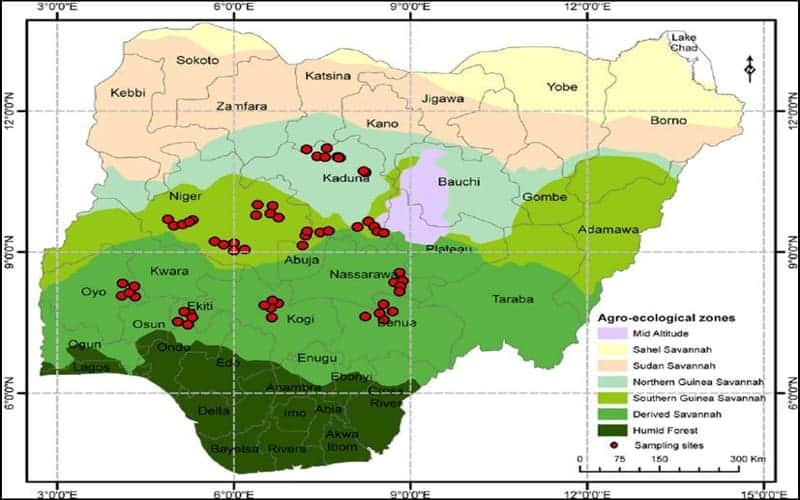Table of Contents
Biomes In Nigeria (Biology | Agriculture)
What is Biomes?
Biomes are broad biotic communities that correlate to vegetation zones or belts. Any significant natural terrestrial ecosystem is referred to as a biome. Any biome’s type is heavily influenced by climatic variables, particularly rainfall and temperature. Consequently, areas of the planet with comparable climates have comparable biomes.

[the_ad id=”451″]
Local Biotic Communities in Nigeria
Nigeria’s regional biotic communities can be divided into two main zones. Which are:
- Forest Zone
- Savanna Zone
1. Forest Zone
The forest zone is mostly made up of trees in its vegetation and contains the following biotic local communities:
- Mangrove swamp forest (salt and fresh water swamp).
- Tropical rain forest
[the_ad id=”453″]
Mangrove Swamp Forest
Location: Areas along the coast, particularly in states like Delta, Cross River, Rivers, Akwa-Ibom, Bayelsa, Ogun, and Lagos, are home to mangrove swamp forests.
Features Of A Swamp Forest
- Tall, woody trees are present.
- Aerial roots are more common in plants.
- It has trees with large, evergreen leaves.
- The biotic community has tilapia fish, oysters, crabs, birds, snakes, and kingfishers, among other animals.
- Prominent plant species in these areas include the red and white mangroves, raffia palm, coconut, etc.
Tropical Rainforest
Location: States like Delta, Ondo, Edo, Imo, Abia, Lagos, Ogun, Anambra, Rivers, Bayelsa, and Akwa-Ibom are home to this biotic group.
Features Of Tropical Rainforest
- Large trees with buttress roots, evergreens, and large leaves make up the vegetation.
- There are different levels or heights of trees, including the bottom or lower, medium, and upper layers.
- It has several parasitic plants, epiphytes, climbers, and creepers.
- Due to the canopy created by the big trees, there is little undergrowth.
- Iroko, Obeche, Mahogany, African walnut, Opepe, ebony, etc. are examples of plant species found here.
- Among the animals that are typically seen are monkeys, birds, snakes, chameleons, squirrels, etc.
[the_ad id=”453″]
Savanna Zone
The savanna zone, which is primarily composed of grasses, is further separated into biotic groups known as savanna belts, including the following:
- Southern Guinea Savanna
- North Guinea Savanna
- Sahel savanna
Southern Guinea Savanna
Location: States like Enugu, Kogi, Benue, Kwara, Oyo, Ebonyi, Osun, and Ekiti include this biotic community.
Features Of Southern Guinea Savanna
- Of all the biotic communities in Nigeria, it is the largest.
- There is moderate rainfall, ranging from 100 to 150 cm.
- Grass is present.
- There are tall trees there with wide leaves.
- The biome is home to numerous significant animals including antelopes, lions, leopards, zebras, etc.
Northern Guinea Savanna
Location: States like Plateau, Kaduna, Bauchi, Niger, Taraba, Adamawa, and Kano are home to this biome.
Features of Northern Guinea Savanna
- Grasses with scattered trees and shrubs dominate the vegetation.
- The annual rainfall falls between 50 to 100 cm.
- There are random short deciduous trees there.
- The grasses are short yet plentiful.
- While some trees have strong bark, many have thorns.
- Typical animals include lizards, lions, leopards, antelopes, snakes, and more.
[the_ad id=”453″]
Sahel Savanna
Location: Only the most northernmost regions of Nigeria, including Bornu, Katsina, Sokoto, Yobe, Kebbi, Zamfara, Kano, and Jigawa, are home to the local biotic community.
Features of the Sahel Savanna
- The biome gets relatively little rainfall and high temperatures (below 50cm per annum).
- The grasses are sparse and short.
- It also features short, sturdy trees or shrubs.
- There are fewer, less prosperous, and patchier grasses.
- The date palm, gum arabic, and acacia are important plant species in this region.
Desert
Location: The northern boundaries of the states like Sokoto, Katsina, Jigawa, Yobe, and Bornu are where this biome is found.
Features of the Desert
- This region sees little or no rainfall
- The humidity is really low and the temperature is high.
- It contains fewer trees, shrubs, bushes and grasses.
- The plants are unique in that they lack leaves, have swollen and succulent stems, extended roots, etc., which allow them to survive in the desert.
- The baobab and cactus trees are typical examples of trees in these areas.

